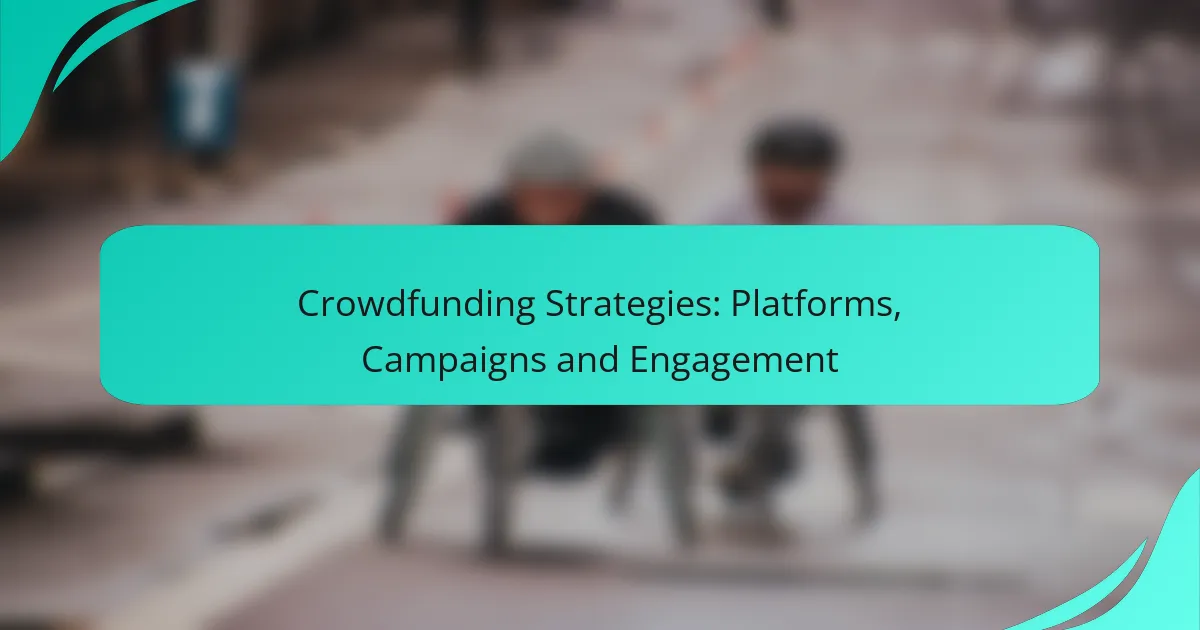Crowdfunding has emerged as a powerful tool for raising funds across various sectors, from creative projects to personal causes. To maximize success, it is crucial to select the right platform that aligns with your campaign goals and to implement effective strategies for engaging potential backers. By setting clear objectives and fostering a strong community, you can significantly enhance your chances of achieving your funding targets.
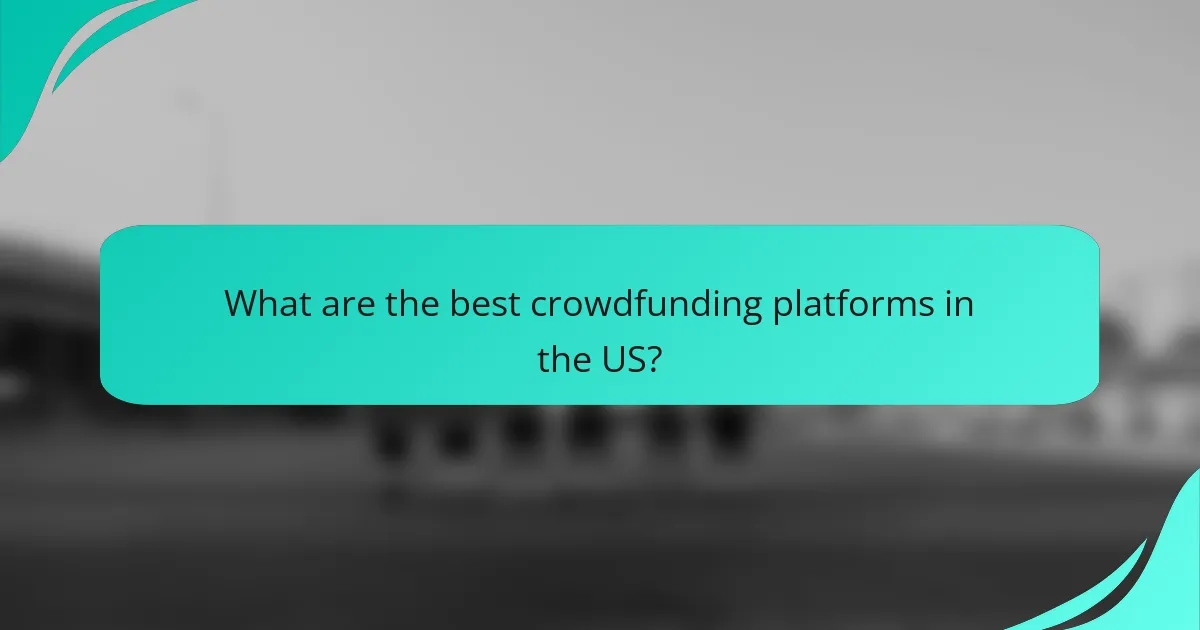
What are the best crowdfunding platforms in the US?
The best crowdfunding platforms in the US cater to various needs, including creative projects, personal causes, and investment opportunities. Each platform has unique features, fee structures, and target audiences, making it essential to choose one that aligns with your campaign goals.
Kickstarter
Kickstarter is a popular platform primarily for creative projects such as art, music, and technology. It operates on an all-or-nothing funding model, meaning projects must reach their funding goal to receive any money. This approach encourages backers to contribute more, knowing their funds will only be used if the project is fully funded.
Creators should consider setting a realistic funding goal and a compelling project description to attract backers. Successful campaigns often include engaging videos and attractive rewards for different pledge levels.
Indiegogo
Indiegogo offers more flexibility than Kickstarter, allowing both all-or-nothing and flexible funding options. This means creators can keep funds raised even if they don’t meet their goal, which can be beneficial for projects with lower funding needs. Indiegogo is suitable for a wide range of projects, from innovative products to personal causes.
Campaigners should leverage Indiegogo’s extensive marketing tools and community features to promote their projects. Offering unique perks and engaging with backers can significantly enhance campaign success.
GoFundMe
GoFundMe is primarily focused on personal fundraising, making it ideal for medical expenses, education costs, and emergencies. Unlike other platforms, GoFundMe does not charge a platform fee, allowing fundraisers to keep more of the donations received. This makes it a popular choice for individuals seeking support from friends and family.
To maximize contributions, fundraisers should share their stories authentically and provide regular updates. Utilizing social media can help reach a broader audience and encourage more donations.
Patreon
Patreon is designed for creators who want to build a sustainable income through ongoing support from their fans. It allows creators to offer subscription-based memberships, providing exclusive content and rewards to patrons. This model is particularly effective for artists, writers, and content creators looking for consistent funding.
Successful Patreon campaigns often include tiered membership levels with varying benefits. Creators should engage regularly with their patrons to maintain interest and encourage ongoing support.
SeedInvest
SeedInvest focuses on equity crowdfunding, allowing startups to raise capital by offering shares to investors. This platform is suitable for businesses looking to scale and attract serious investors. SeedInvest has a rigorous vetting process, ensuring that only high-quality startups are listed.
Entrepreneurs should prepare a solid business plan and financial projections to attract investors. It’s crucial to communicate the potential return on investment clearly and maintain transparency throughout the campaign.
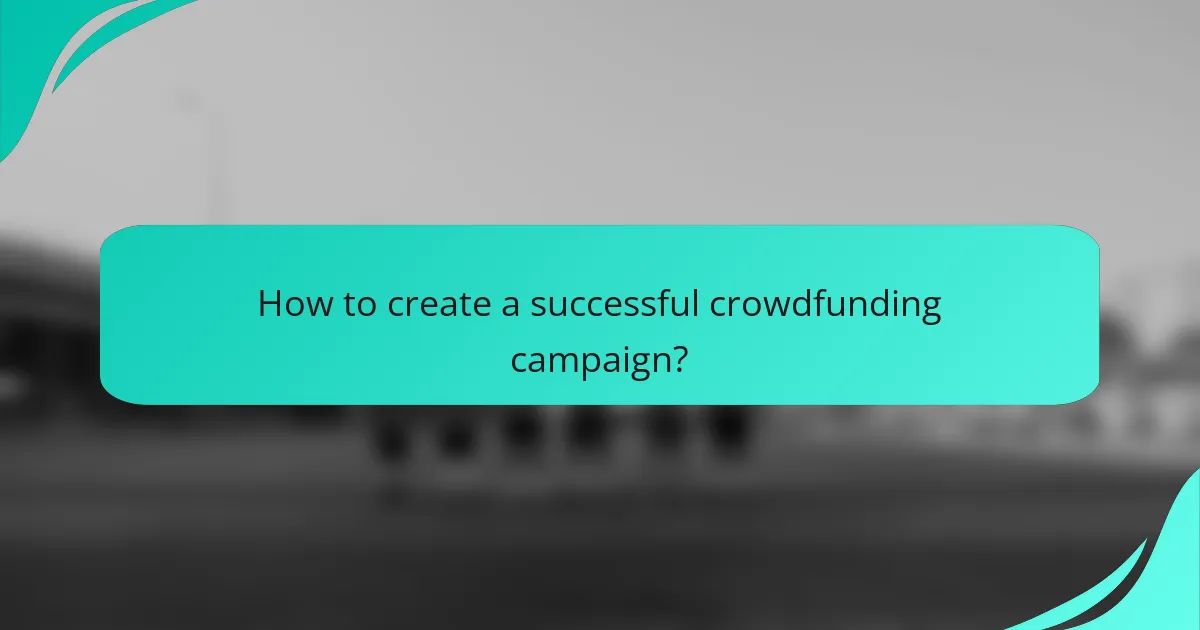
How to create a successful crowdfunding campaign?
Creating a successful crowdfunding campaign involves setting clear objectives, engaging potential backers, and leveraging social media effectively. A well-structured approach can significantly increase your chances of reaching your funding goals.
Define clear goals
Establishing clear goals is essential for any crowdfunding campaign. These goals should include the total amount you aim to raise, the purpose of the funds, and a timeline for achieving your objectives. For instance, if you are raising $10,000 to launch a product, specify how the funds will be allocated.
Consider breaking down your goals into smaller milestones. This can help maintain momentum and encourage backers to contribute as they see progress. For example, you might set a goal of $2,500 for the first week, which can create urgency and excitement.
Engage your audience
Engaging your audience is crucial for building a supportive community around your campaign. Start by identifying your target demographic and tailoring your messaging to resonate with them. Use storytelling to connect emotionally, sharing your vision and the impact of their support.
Regular updates and interaction with backers can foster a sense of involvement. Consider hosting Q&A sessions or live streams to answer questions and provide insights into your project’s development. This transparency can enhance trust and encourage more contributions.
Utilize social media
Social media is a powerful tool for promoting your crowdfunding campaign. Platforms like Facebook, Instagram, and Twitter can help you reach a wider audience and generate buzz. Create engaging content, such as videos and infographics, to capture attention and encourage shares.
Develop a content calendar to schedule posts leading up to and during your campaign. Consistency is key, so aim to post updates, behind-the-scenes content, and reminders about your funding goals regularly. Additionally, consider using paid advertising to target specific audiences who may be interested in your project.
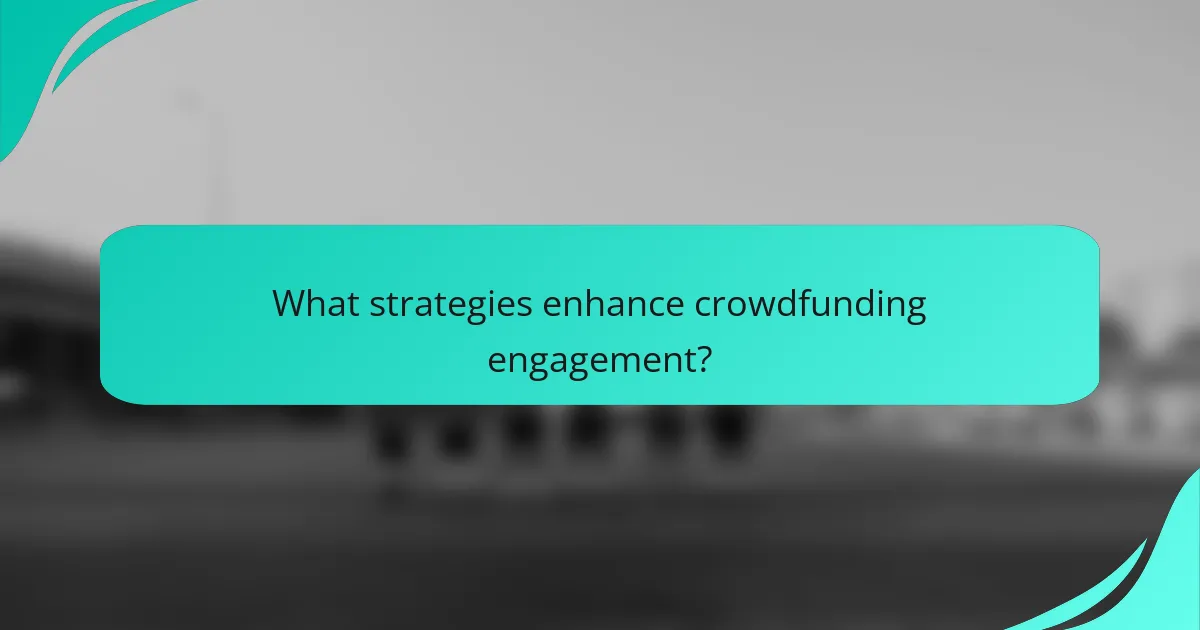
What strategies enhance crowdfunding engagement?
Effective crowdfunding engagement strategies focus on maintaining communication, providing incentives, and fostering a sense of community among backers. These approaches can significantly increase support and funding throughout a campaign.
Regular updates
Regular updates keep backers informed and engaged with the progress of the campaign. Sharing milestones, challenges, and behind-the-scenes content can create a narrative that encourages continued support. Aim for updates at least once a week to maintain interest.
Consider using various formats for updates, such as videos, images, or written posts. This variety can cater to different preferences and enhance the overall engagement experience.
Incentives for backers
Offering incentives is a powerful way to encourage contributions. These can range from small tokens of appreciation, like thank-you notes, to larger rewards, such as exclusive products or experiences. Clearly outline what backers will receive at different contribution levels to motivate them.
Ensure that the incentives are appealing and relevant to your target audience. For example, if you’re launching a tech gadget, offering early access or discounts can be particularly enticing for tech enthusiasts.
Community building
Building a community around your crowdfunding campaign fosters loyalty and encourages backers to spread the word. Utilize social media platforms and dedicated forums to create spaces where backers can interact, share ideas, and provide feedback.
Engage with your community by responding to comments and questions promptly. Consider hosting live Q&A sessions or virtual meetups to strengthen connections and enhance the sense of belonging among supporters.
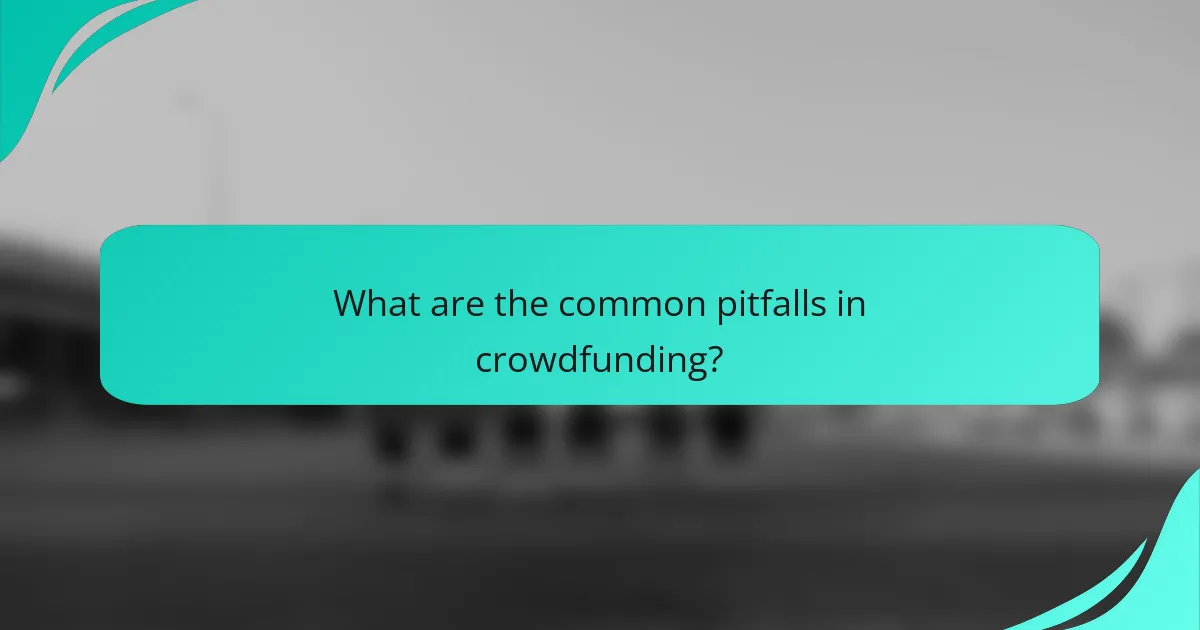
What are the common pitfalls in crowdfunding?
Common pitfalls in crowdfunding include setting unrealistic funding goals, poor marketing efforts, and a lack of transparency. These issues can significantly hinder a campaign’s success and discourage potential backers.
Unrealistic funding goals
Setting unrealistic funding goals can lead to campaign failure. If the target amount is too high, it may deter potential backers who feel the goal is unattainable. Conversely, setting a goal that is too low might not cover the actual costs of the project.
A good practice is to research similar campaigns to gauge appropriate funding levels. Aim for a target that not only reflects your needs but also considers the average contributions from backers, which often range from $25 to $100.
Poor marketing efforts
Poor marketing efforts can leave a crowdfunding campaign unnoticed. Without a solid marketing strategy, even the best ideas may struggle to gain traction. Utilize social media, email newsletters, and press releases to reach a wider audience.
Consider creating engaging content such as videos or infographics to showcase your project. A well-planned marketing campaign should ideally begin weeks before the launch and continue throughout the campaign to maintain momentum.
Lack of transparency
A lack of transparency can erode trust between campaign creators and backers. If potential supporters feel uncertain about how their funds will be used, they are less likely to contribute. Clearly outline your budget and project timeline to build credibility.
Regular updates during the campaign can also enhance transparency. Share progress, challenges, and any changes to the project to keep backers informed and engaged. This openness fosters a sense of community and encourages ongoing support.
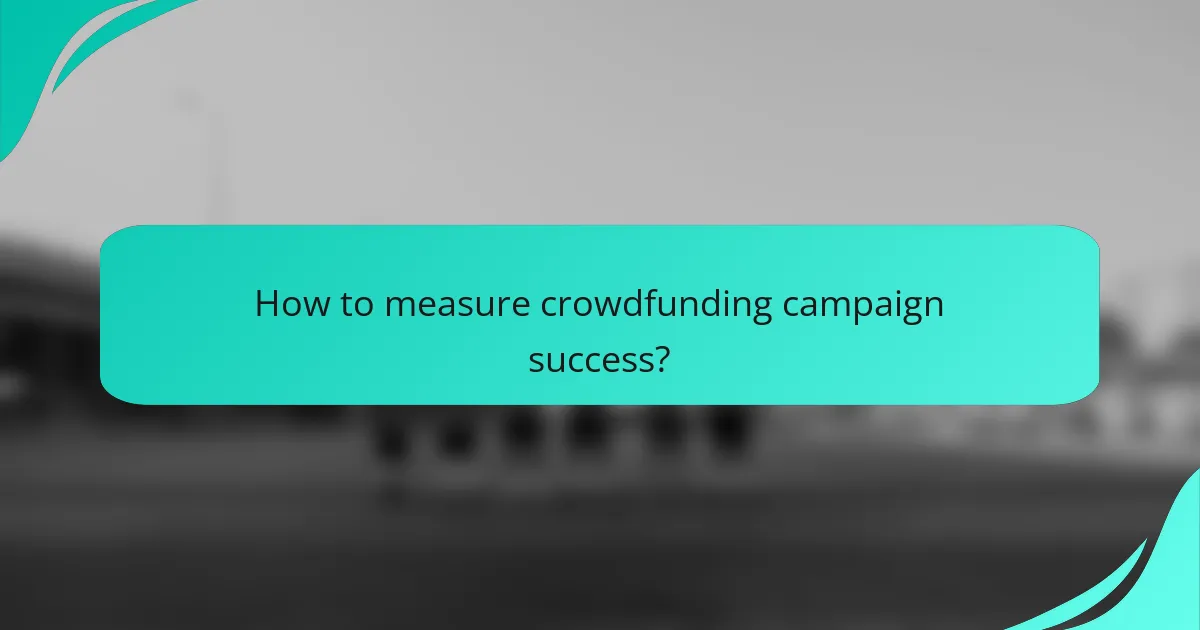
How to measure crowdfunding campaign success?
Measuring the success of a crowdfunding campaign involves evaluating various metrics that indicate its effectiveness. Key indicators include the total funding amount achieved, the number of backers, and the engagement levels throughout the campaign.
Funding amount achieved
The funding amount achieved is the most straightforward measure of a crowdfunding campaign’s success. It reflects the total financial contributions received from backers and indicates whether the campaign met its funding goal.
To assess this metric, compare the total funds raised against the initial target. A campaign that exceeds its goal by a significant margin can be considered highly successful, while one that falls short may need to reevaluate its strategy. For instance, campaigns that raise 20-30% above their target often indicate strong market interest.
Consider setting realistic funding goals based on market research and similar campaigns. Avoid overly ambitious targets that may discourage potential backers. A common pitfall is failing to account for platform fees, which can reduce the final amount received; typically, these fees range from 5-10% of the total funds raised.
